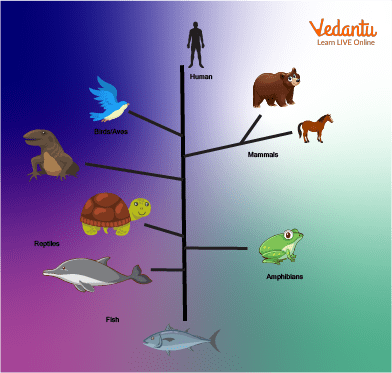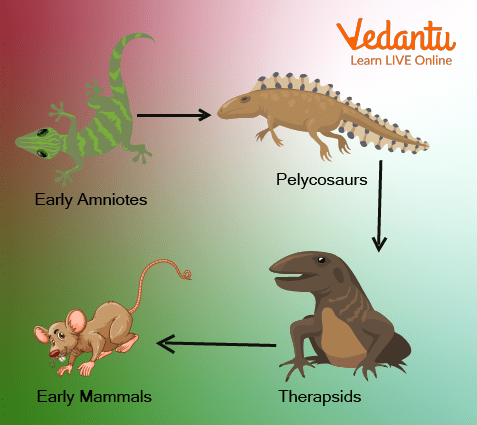




History of Evolution of Earth
Life on Earth originated roughly 4.5 billion years ago when it was formed. Scientists have used fossilised records of creatures to link and date the evolution of life. At the time, life was limited to single-celled organisms. A single-celled creature, also known as a unicellular organism, is an organism made up of only one cell, which performs all of the necessary functions for life.

First Mammals on Earth
A multicellular organism has numerous cells, meaning distinct cells specialise in performing certain functions, as in animals. Organisms with eukaryotic cells are found in the domain Eukarya; these eukaryotes are distinguished by their numerous cells containing nuclei and membrane-bound organelles. This means the cell membranes have a threshold or membrane that aids cell adhesion.
How and When Did Animals First Appear on Earth?
Animals evolved by evolution, which is the change in a species' features over multiple generations. Evolution can be triggered by:
Mutation: a change in an organism's genetic material
Migration: the movement or relocation of organisms to a different geographical area.
Natural Selection: organisms best adapted to their environment survive and pass on their genetic material to their descendants.
Genetic Drift: species features becoming more or less prevalent, as measured by allele frequency.
Non-Random Mating: species select mates based on certain characteristics.
Cells are the building blocks of life and can be prokaryotic or eukaryotic. Animalia, Plantae, Fungi, Protista, and Monera are the five kingdoms of life. Single-celled creatures, made up of prokaryotic cells, were the first to occupy Earth.
Prokaryotic means "before-nucleus," and they comprise only one of the five kingdoms, Monera, which includes both Eubacteria and Archaebacteria. The remaining four kingdoms of life are made up of multicellular organisms.
Animals, whatever their origins, may have gone onto land during the Cambrian period. Scientists previously believed that animals did not begin to colonise the land until 440 - 410 million years ago.
A Chart of the Evolution of Animals
The chart below depicts all of the different branches of animal evolution.

Chart of the Evolution of Animals
Correct Line of Evolution of Mammals
Amniotes are descendants of amphibians. They divide into two major branches after losing their reliance on water. Modern reptiles and birds would descend from one branch, while mammals would descend from the other.
The mammals' predecessors were once the dominant animals on land. However, the early mammals' hold on the land was eroded after two terrible extinction events.

Evolution of Mammals
Reptiles took over during the Triassic Period. The dinosaurs evolved into one of the most successful animal groupings the world has ever known.
However, the common ancestor of all mammals first appeared during the Triassic Period. Mammalian features were most likely formed when early mammals shared Earth with dinosaurs.
The Cretaceous-Paleogene Extinction Event marked the end of the dinosaurs and the start of the Cenozoic Era, sometimes known as the "Age of Mammals."
Some Evolution Examples in Animals
The interaction between genetic modifications and natural selection, commonly known as "survival of the fittest," is called evolution. Charles Darwin famously researched different species to see how environmental adaptations allowed them to survive. Natural selection shows a species' determination to pass on advantageous genes and how well it can use its features to thrive in its environment.
Here are some examples of species evolution and modifications across many generations.
1. The Peppered Moth: Because of the pollution of the time, this light-coloured moth grew darker following the Industrial Revolution. This mutation enabled black peppered moths to blend in with their shooty surroundings and evade predators. Most peppered moths became black instead of light, but the lighter colour was restored to the population as pollution levels dropped.
2. Peacocks in Vibrant Colours: Females always prefer the male peacock with the most vibrantly colourful feathers. Male kids have a better chance of finding a spouse and passing along their genes since the genes for brilliant features are passed down to them.
3. Birds that Cannot Fly: Birds that cannot fly include ostriches, emus, and penguins. This wasn't always the case; these flightless birds had relatives who could fly. Ostriches and emus evolved over many generations to have larger bodies and feet designed for running on the ground, leaving them without the capacity (or need) to fly. The same is true for penguins, who have traded traditional wings for swim-friendly flippers over thousands of generations.
4. Ant Warrior: These ants carry a chemical signal that allows them to identify their colony. Some ants learned to duplicate this signal from another colony to assault and take over a colony. The worker ants will not even notice the invasion and will continue to work.
Summary
Evolution is a continuous process; It has been going on for hundreds of millions of years. Animals have evolved from unicellular microorganisms to their current form through the evolution process. Many examples of animals show that the process is ongoing and is never over.
FAQs on Evolution of Animals
1. What is the evolution of animals?
The evolution of animals is the process of gradual change in the heritable characteristics of animal populations over successive generations. This process, driven by mechanisms like natural selection and genetic drift, has led to the vast diversity of animal life on Earth, from the simplest single-celled ancestors to complex vertebrates. It explains how new species arise and others become extinct over millions of years.
2. What are the main mechanisms that drive animal evolution?
There are four primary mechanisms that drive the evolution of animals:
- Natural Selection: The process where animals with traits better suited to their environment are more likely to survive, reproduce, and pass those advantageous traits to their offspring.
- Genetic Mutation: Random changes in an organism's DNA that can create new traits. While many mutations are neutral or harmful, some can be beneficial and are favoured by natural selection.
- Gene Flow: The transfer of genetic material from one population to another. This occurs when animals migrate and interbreed, introducing new genetic variations.
- Genetic Drift: Random fluctuations in the frequencies of traits in a population, which has a more significant effect in smaller populations.
3. What evidence supports the theory of animal evolution?
The theory of animal evolution is supported by multiple lines of evidence from different scientific fields. Key evidence includes fossils that show a progression of life forms over geological time, comparative anatomy (like homologous and analogous structures), embryology which reveals developmental similarities among related species, and molecular biology, where DNA and protein similarities show genetic relationships between different animals.
4. What was the first animal to evolve on Earth?
While it is difficult to pinpoint the exact first animal, scientific evidence suggests that the earliest animal life likely resembled modern-day sponges or ctenophores (comb jellies). These simple marine invertebrates appeared over 600 million years ago and represent the base of the animal evolutionary tree, lacking the complex tissues and organs found in most later animals.
5. What is the difference between homologous and analogous structures in animals?
Homologous and analogous structures are important concepts in understanding evolutionary paths.
- Homologous structures are features shared by related species because they have been inherited from a common ancestor. For example, the forelimbs of humans, cats, whales, and bats have the same basic bone structure but are adapted for different functions.
- Analogous structures are features that serve similar functions in different species but evolved independently, not from a common ancestor. For example, the wings of a bird and an insect both allow for flight but have very different structural origins.
6. How does natural selection lead to the evolution of new animal species?
Natural selection leads to new species through a process called speciation. It begins with variation within a population. If a population gets separated into different environments, each group faces unique pressures. Natural selection favours different traits in each group. Over many generations, the accumulated genetic differences can become so significant that the two groups can no longer interbreed, at which point they are considered distinct species.
7. When did major animal groups like mammals and dinosaurs first appear?
Major animal groups appeared at different points in Earth's history. The first dinosaurs evolved during the Triassic period, around 243 to 233 million years ago. The first true mammals appeared around the same time, evolving from mammal-like reptiles. However, mammals remained small and largely nocturnal, only diversifying into the major groups we see today after the extinction of the non-avian dinosaurs about 66 million years ago.
8. Why is genetic variation so important for the survival and evolution of animal populations?
Genetic variation is the cornerstone of evolution and survival. A diverse gene pool provides a population with a range of traits. When the environment changes (e.g., a new disease appears or climate shifts), some individuals will likely have traits that allow them to survive and reproduce. Without this variation, the entire population could be wiped out by a single event, as no individuals would possess the necessary adaptations to cope with the new challenge. It is the raw material upon which natural selection acts.









